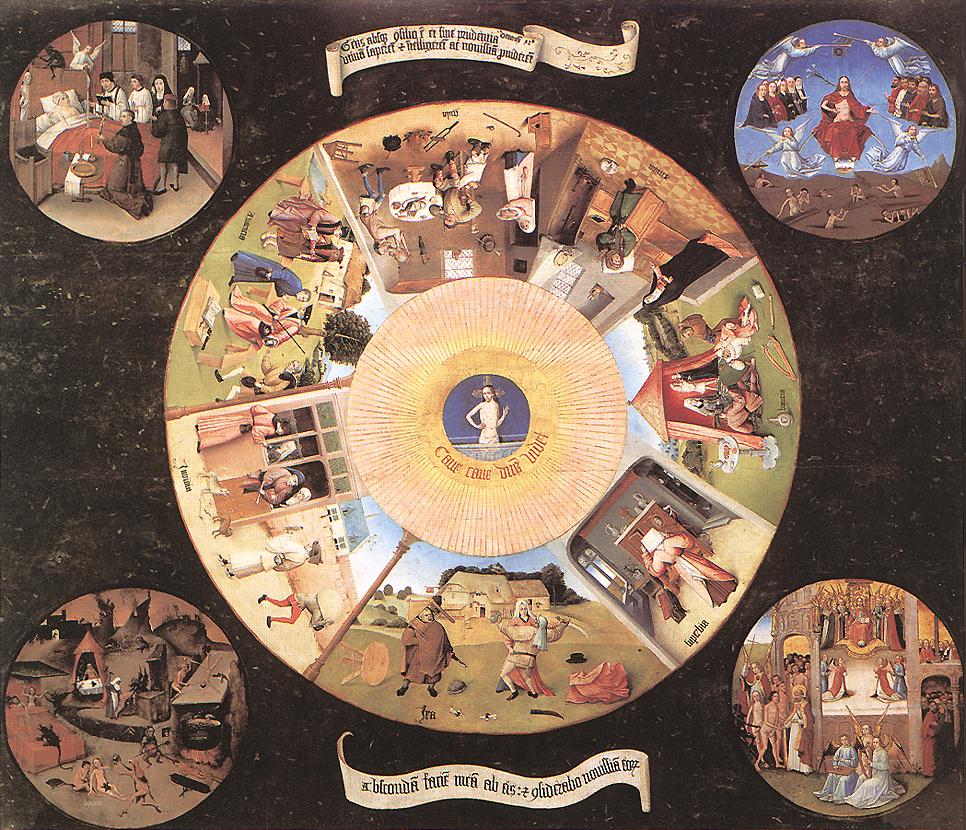|
|
|
|
home
|
|
BOSCH, Hieronymus (b.
cca. 1450, s’Hertogenbosch, d. 1516,) ARTISTS
BEFORE 1650/ MAIN ART
|
original
lfff site
|
|
Brilliant and original northern European
painter of the late Middle Ages whose work reveals an unusual
iconography of a complex and individual style. His real name was Jerome
van Aeken (also spelled Aken or Aquen). Although at first recognized as
a highly imaginative "creator of devils" and a powerful inventor of
seeming nonsense full of satirical meaning, Bosch demonstrated insight
into the depths of the mind and an ability to depict symbols of life and
creation.
Bosch was a pessimistic and stern
moralist who had neither illusions about the rationality of human nature
nor confidence in the kindness of a world that had been corrupted by
man’s presence in it. His paintings are sermons, addressed often to
initiates and consequently difficult to translate. Unable to unlock the
mystery of the artist’s works, critics at first believed that he must
have been affiliated with secret sects. Although the themes of his work
were religious, his choice of symbols to represent the temptation and
eventual ensnarement of man in earthly evils caused many critics to view
Bosch as a practitioner of the occult arts. More recent scholarship
views Bosch as a talented artist who possessed deep insight into human
character and as one of the first artists to represent abstract concepts
in his work. A number of exhaustive interpretations of Bosch’s work have
been put forth in recent years, but there remain many obscure details.
An exact chronology of Bosch’s surviving
work is difficult because, of the approximately 35 to 40 paintings
attributed to him, only 7 are signed and none are dated. There exists
little documentary information on the early life of the artist, other
than the fact that he was the son and grandson of accomplished painters.
His name does appear on the register of the Brotherhood of Our Lady,
located in the city of his birth, and there is mention of him in
official records from 1486 until the year of his death, when he was
acclaimed an Insignis pictor ("distinguished painter"). In addition to
painting he undertook decorative works and altarpieces and executed
designs for stained glass.
In these early paintings Bosch had begun
to depict humanity’s vulnerability to the temptation of evil, the
deceptive allure of sin, and the obsessive attraction of lust, heresy,
and obscenity. In calm and prosaic settings, groups of people exemplify
the credulity, ignorance, and absurdities of the human race. However,
the imagery of the early works is still relatively conventional, with
only an occasional intrusion of the bizarre in the form of a lurking
demon or a strangely dressed magician.
Bosch’s preoccupation in much of his work
with the evils of the world did not preclude his vision of a world full
of beauty. His adeptness at handling colour harmonies and at creating
deeply felt works of the imagination is readily apparent. Though a spate
of imitators tried to appropriate his visual style, its uniqueness
prevented his having any real followers.
|
film and food |
|
literature and food |
|
music
and food
|
artists before 1650 bookshop (UK)
Hunger as Divine: Dante’s Divine Comedy |
|
|
|
|
|
|

|
|
|
The Seven Deadly Sins
c. 1480
Panel, 120 x 150 cm
Museo del Prado, Madrid
|
|
|
This is one of Bosch’s earliest known
works and reflects the style and preoccupation which would later come to
be considered characteristic of him. It belonged to Philip II King of
Spain, who kept it in his apartments at the monastery of the Escorial.
The Seven Deadly Sins is a painted
rectangle with a central image of the eye of God with Christ watching
the world. The Seven Deadly Sins, depicted through scenes of worldly
transgression, are arranged around the circular shape. The circular
layout with God in the centre represents God’s all seeing eye: No sin
goes unnoticed. In the corners of the image appear the "Four Last
Things" (the last four stages of life) mentioned in late medieval
spiritual handbooks: Deathbed, Last Judgment, Heaven, and Hell, all of
which are favourite themes of separate Bosch panels.
In the centre, fanned out around the
figure of Christ, appear seven scenes each illustrating one of the Seven
Deadly Sins, bearing the appropriate inscription and composed with the
painter’s usual vivacity and sense of the fantastic. (1) Anger presents
a scene of jealousy and conflict; (2) in Pride, a demon presents a woman
with a mirror; (3) in Lust, two sets of lovers speak within the confines
of an open tent, entertained by a buffoon, while on the ground outside
lie various musical instruments, including a harp which will reappear in
the ‘Garden of Earthly Delights’; (4) Idleness is represented by a woman
dressed up for church and trying to wake a man deep in slumber; (5)
Gluttony shows a table spread with food and around it figures eating
voraciously;
(6) Avarice
displays a judge allowing himself to be bribed; and (7) Envy depicts the
Flemish proverb ‘Two dogs with one bone seldom reach agreement’.
|
|
Artprice.com: 306,000 listed artists
Check the accurate prices with 3.7 million auction records & artists’ key indices, discover the biography of emerging & renowned artists, see detailed upcoming auctions, check 36,000 artists signatures. Take advantage of our free email alert on your listed artists! |
|